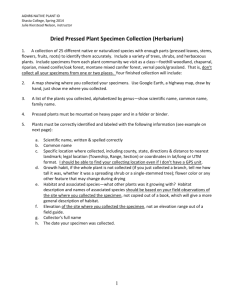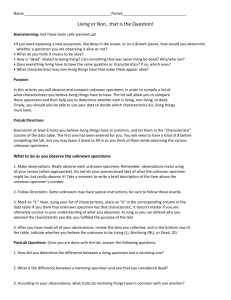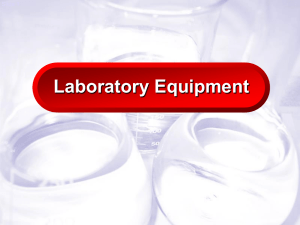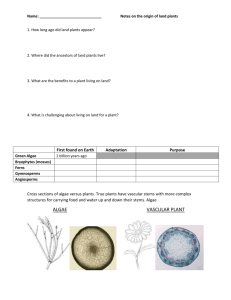Make your own Herbarium BIOL 203L Ecology and Evolution Dr
advertisement
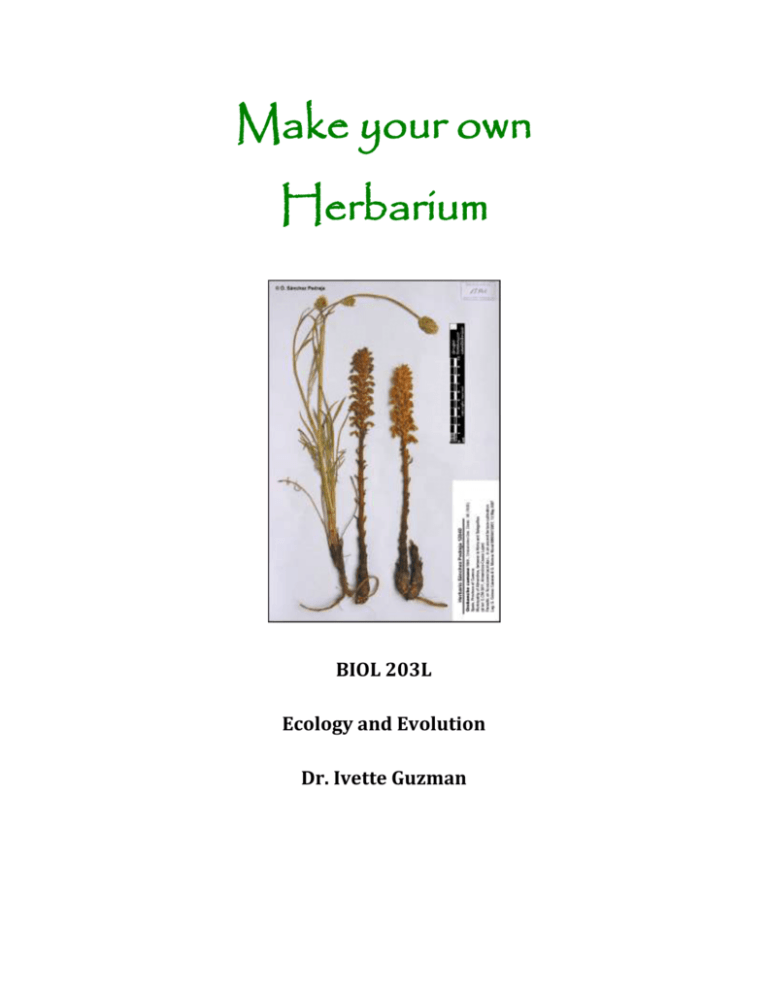
Make your own Herbarium BIOL 203L Ecology and Evolution Dr. Ivette Guzman 1. Introduction A herbarium (plural: herbaria) is a collection of preserved plant specimens. Herbarium specimens form an important record of what plants grew where over time. They may have been produced as a voucher for an environmental survey or botanical research, and serve as a permanent record allowing anyone to go back and check the identification, re-sample or repeat research. The production of herbarium specimens is therefore an important, but often forgotten aspect of botanical studies. There are four main aspects to making good herbarium specimens: • collecting • pressing & preserving • mounting • labeling Quality herbarium specimens are an important recourse and require both skill and dedication to produce. They require care when collecting and pressing together with accurate, detailed labels. 2 Materials Collection bags – sandwich/pint size ziplocs Large collection bag – grocery bag to place all small bags Field notebook – small preferably hardback for note taking Pencil – easier to write with and prevent smudging of pen ink Scissors – used for cutting Newspaper – used for pressing Plant press or heavy books – used to apply pressure on plants in newspapers 2. Collecting 2.1 What to collect When collecting plants for herbarium or voucher specimens there are two basic points to remember: • Include all available parts of the plant (i.e. all reproductive structures such as fruits, flowers and buds, as well as bark, leaves, etc.) • Include detailed notes about the plant and it's surroundings. When in the field it is a good idea to collect two samples. While in the field, always record details of the plant in your field notebook. Do not rely on your memory! This information will later be included on the specimen label. Before venturing out in to the field always consider the laws and ethics governing the collection of plant material. Collecting illegally can result in hefty fines and even jail. The ideal specimen for identification and research is an entire plant, roots and all. Leaves alone are virtually useless. You should try to collect as much of the plant that is practical and possible given the size of the plant and which parts are most informative. 3 In general aim to collect: • At least the terminal parts of the aerial shoots including leaves and reproductive parts (leaves, flowers, buds and fruits). • A representative sample (do not simply choose the biggest or prettiest). • More than one specimen from a single plant if the plant is variable (e.g. juvenile leaves at the base, adult leaves higher up). These will be given the same collecting number. • One specimen from different plants, if you are trying to show variation within a population. Specimens collected from different plants will have to be numbered separately. • Collect at least a couple of specimens of each plant. There are also specific collecting recommendations for different types of plants: • Ferns, herbaceous angiosperms (ex: grasses and herbs) • Woody plants (shrubs and trees) 2.2 Field Notes Without detailed, accurate information, a herbarium specimen is almost useless. You should write notes while in the field collecting. Do not rely on your memory! A hard backed exercise book makes a great field notebook. In your field notebook you should: • Use a waterproof pen or pencil so your notes are not lost in the rain or mist. • Write your contact details in the front cover so the book can be returned to you if lost. • Stick a copy of a herbarium label in the back cover to remind you what information is required. • Use one page per specimen so you have additional room if you need to add information later. 4 2.3 Numbering and tagging Record numbers are used to identify different herbarium specimens to their information in your field notebook. The best numbering system is the simplest: start from number 1 and continue for the rest of your collecting career. Use your initials in front of the number to differentiate your collection from someone else's (ex: IG133). Specimen numbers are recorded in your notebook and on a tag/piece of paper that is attached to the specimen to link the two. 2.4 Specimen Preservation in the Field Plants with delicate petals wilt and shrivel quickly once picked, resulting in poor quality herbarium specimens. The best but not necessarily the most practical way to reduce this, is to take your plant press into the field and immediately press specimens as you collect them. 5 As this is not always practical or possible, labeling specimens with tags then storing them in sealed plastic bags out of the sun, is ok on cool days. To maintain specimen quality especially on hot days: • Maintain humidity inside plastic bags by swirling a small amount of water inside the bag first, • Dampen some folded handtowel and place this in the bag with the plants, • Put the specimen filled plastic bags straight into an iced cooler. Once picked, most specimens will maintain turgor for a few days if kept in a sealed plastic bag in the fridge prior to pressing. Specimens such as aquatic plants and delicate flowers deteriorate rapidly. These should be kept in extremely humid air, or pickled or pressed immediately. 2.5 Collecting Ferns, Grasses and Herbs Collect the entire plant including underground organ/s (roots, rhizomes, tubers, etc), inflorescences (flowers), infructescences (fruits) and other fertile structures. If the plant is small it is a good idea to collect multiple plants (as long as they all come from the one population). These can all be given the same collecting number and put on the same sheet of herbarium card. 6 2.6 Collecting Shrubs and Trees In addition to the general points on collecting, it is also a good idea to collect bark (especially for some trees like junipers) either from the trunk or ground, but make sure to note where it came from and how far up the tree. If the plant shows adult/juvenile/coppice or sun/shade leaf differences then collect and note these differences. 2.7 Laws and ethics of collecting Laws Prior to collecting, it is important to consider the legislation, ethics and health and safety aspects associated with plant collecting. When taking plants from public or private lands (reserves, state forest, road verges, railway lines, public gardens, cemeteries, schools), always seek consent of the landowner. This may mean contacting the local council that looks after the garden, speaking to the gardener in charge, farmer, caretaker, etc. Being a botanist or collecting for this course will not save you from prosecution. Note: A number of native plants are considered rare and endangered and must NEVER be collected as they are legally protected. 2.8 Ethics Always respect and care for the environment from which you are taking flora. No matter where you are collecting, always take only the minimum amount of material required and never collect more than 25% of a single population or more than 10% 7 of the reproductive material. Endeavour to collect away from the public eye, as others seeing you may not realize that you are collecting in the name of science. Health and Safety Be familiar with poisonous plants that could cause skin irritation. Do not ingest plants, which could be toxic to your health. Preserving and Pressing 3.1 The Preserving Process Herbarium specimens are generally preserved by pressing until dry, or pickling in a liquid. Pressing means to apply enough pressure to hold the plant in a position that best displays the botanical features while drying. The keys to achieving well-pressed plants are: • Dry them as quickly as possible in a good plant press. • Care for the specimens as they dry. Plant Press Plant presses come in various forms but usually consist of two wooden boards or lattices (30 x 45 cm), cardboard and newspaper arranged like a sandwich (pictured below). Straps or belts are wrapped around the press to hold it together. 8 To construct a press open a sheet of newspaper, place your plant on one side and fold over the top of the specimen. Newspaper or large sheets of blotting paper (paper towels) are used as they absorb moisture from the specimens. On top and below this plant/newspaper sandwich place a sheet of cardboard. Corrugated cardboard is better than solid cardboard as it allows the air to circulate within the press, helping the specimens to dry quickly. Cardboard is also important within the press as it provides flat surfaces to dry the specimens against. To complete the plant press, stack several plant/newspaper/cardboard sandwiches together and place wooden boards or heavy books on the top and bottom. Around the stack, wrap rope, leather belts or nylon straps and tie or fasten to hold the press together and apply pressure. If you do not have a plant press, pressure may be applied by piling telephone or heavy textbooks on top. Either way, the pressure should be even across the specimen so they dry flat. Specimens with bulky parts (e.g. seeds) may require thick folds of newspaper around bulky fruits or branches so that pressure is transferred to the less-bulky leaves and flowers. Remember, the aim is not to squash the water out of the specimens, just to hold them flat in position while they dry. Care while drying Once in the press it is important that specimens are dried as quickly as possible to prevent them from going mouldy. Normally specimens take 7-14 days to dry depending on the air temperature, humidity and the dampness and/or succulence of the plants. 9 The following suggestions will help to dry your specimens quickly: • Use a lattice press. • Use cardboard with internal corrugations. • Use blotting paper to absorb the moisture. • Stand the press in a warm, dry place, e.g. a cabinet-type clothes drier set at low heat. Be careful not to burn the specimens or press. • Replace the newspaper to remove moisture and fungal spores. Replacing Newspaper and Rearranging Specimens It is important that specimens are checked regularly while drying to ensure that insect or fungal attack does not occur, and to reposition the plants. Initially Newspaper sheets should be replaced daily to remove moisture and spores. After the third day this can be done every 2-3 days until the specimens are dry. When changing the newspaper re-position the specimens while they are still pliable. When rearranging, aim to achieve the following: • Ensure all botanical features are showing, including both lower and upper leaf surfaces. • Make sure the specimens will fit on the mounting card when dry, remembering to leave space in the bottom right hand corner for the label! Keep a picture in your mind of what you want the final herbarium specimen to look like - once the specimen dries you won’t be able to move it. If your specimen is too big to fit on a single sheet of herbarium card pruning, overlapping or folding the specimen when pressing may help. If all else fails, cut the specimen in half and mount it on two sheets of card. If you do this, however, you 10 will have to put a label on each sheet and note the total number of sheets on each label (eg. "Sheet 1 of 2"). For long specimens (eg. grasses, sedges, daisies) fold the flowering stalk into a zigzag when drying to fit it on a single sheet (as left). Handling Specimens Always handle your specimens with care to prevent them from breaking or parts from falling off. As they dry however, some plants inevitably drop their leaves, seeds or flowers. If this happens, collect these parts and put them into a labelled paper envelope alongside the drying specimens. These will be added to the herbarium specimen at the mounting stage. By following the above notes you should create good quality specimens. Some specimens do however require a little more care when pressing and drying: • Succulent or fleshy vascular plants and fruits • Aquatic Plants Preserving Succulents Succulent or fleshy vascular plants and fruits are prone to fungal damage and require additional care. To prevent this and also to aid drying, change the paper more regularly or use more absorbent paper such as blotting paper. Prior to pressing it may help to immerse or brush the specimen with alcohol to kill fungi (see Pickling for alternative ways to preserve fleshy plant parts). If fleshy fruits are separate from the herbarium specimen, place them in a labelled paper bag and leave this next to the plant press rather then in it. Check and change the paper bag frequently. 11 4. Mounting To mount a specimen means to adhere it onto a sheet of herbarium card. A well mounted specimen should display both artistic and botanical qualities. It should be arranged on the card in a balanced, aesthetically pleasing way, paying attention to: • Orientation and type of mounting card. • Arranging and attaching the specimen. • Position of label and accompanying annotations. • Keeping loose parts in specimen bag. 4.1 Mounting card/page. The direction of the card is portrait. Mount on thick heavy white paper. 4.2 Arranging the Specimen If pressed correctly, the plant specimen should fit perfectly on the mounting card. When arranging the specimen: • Leave a 2 cm border around the edge to allow space for turning the page. • Single specimens should be centered on the mounting card and are usually placed vertically or diagonally across the sheet. 12 • Small plants with multiple specimens should be arranged in evenly spaced rows spread over the whole card. • Orientation of the plants should represent their habit, i.e. usually flowers to the top and roots towards the bottom. • Flip the specimens onto the side that displays the most botanical features (i.e. flowers, fruits, both sides of leaves, etc). 4.3 Attaching the Specimen Specimens can be attached to the mounting card by gluing, sewing or with tape. Although gluing is the quickest method, it is also the least flexible as glued specimens can not be removed to expose the underside and can not be remounted. When using clear tape: • Tape should be centred over the branch/stem/leaf with equal length flaps on each side. • Place tape perpendicular to the branch, stem or leaf midrib. 13 • Do not tape over important botanical information ie ligules, flowers, fruits, stipules, etc. • Hide tapes under neighboring leaves where possible. • Use sufficient tape to secure specimen to the card so that it does not move, but not too much as it will destroy the beauty of the specimen. This usually equates to approximately 3-4 pieces of mounting tape for each 40 cm long main branch. • Extra tape may be needed to support delicate specimen parts near edges of the card or heavy parts such as woody fruits. 4.4 Specimen Bag/Envelope Any parts of the specimen that break off must be kept. When dry place loose parts in a small polyethylene plastic bag or a paper envelope, fasten to the label and herbarium card with the specimen. Points to remember regarding the specimen bags include: • Use the smallest sized bag appropriate to the contents. • Place a small label inside the plastic bag or write on the envelope details such as species name, collector/s and date to identify which specimen the bag belongs. • Hang from top left hand corner unless this overlaps with the specimen.. • Fasten the bag with a plastic or 'owl' type paperclip as these don't have sharp edges. Paper envelopes may be stuck to the mounting card with glue. • Do not place parts in a plastic bag until they are completely dry as they will go mouldy 4.5 Attaching the Label The label contains information about the specimen that has been copied from the field notebook plus additional notes relating to the specimen's name and identification. When attaching the label you should always: • Place label in the lower right hand corner. • Place 1cm in from the edge of the card to allow space for holding and to prevent damaging the label. 14 • Use archival clear gum glue. • Glued down along the top edge only. • Keep the label free from mounting tape and specimens. 4.6 Annotation Slips Determinavit and confirmavit slips are small pieces of paper used to indicate determination (det.) or confirmation (conf.) of the spicimen's nomenclature. Annotation slips usually indicate the species new name, date of identification and signature of the person who did the identification. The species name on the det. or conf. slip always overrides the name on the label. If numerous slips are present, the correct name of the species is that with the most recent date. Det. and Conf. Slips are always: • Only stuck down along one end. This is the end closest to the edge of the mounting card. • Positioned 1-2 mm above and in line with the herbarium label. Place the det. slip next to the label if there is no room above the label. 15 Additional slips should be placed above previous slips n the right-hand side of the mounting card 5. Labeling A sample herbarium label Herbarium NO. IG201 Technical Name Lamium amplexicaule Common Name Henbit Family Labiatae Locality South UTSA campus Habitat Edward’s Plateau Date 2-18-2001 Collected by Ivette Guzman Without accurate information accompanying a herbarium specimen, it is almost worthless. Traditionally herbarium labels were hand written, but today most herbaria use database systems from which labels are printed. The following list illustrates the type of information and detail required on a herbarium label. At a minimum your label should include: • Family and scientific name of the specimen, including the authority. • Collector's name/s. • Date of collection. • Locality where the plant was collected, including latitude and longitude. If possible also include: • Collector's specimen record number • Name of the person who determined the identification • Altitude • Habitat or type of plant community 16 • Habit • Any other details about the plant that may be important171 Remember that the information on the label is specific to your specimen and may differ from the species description. Also, the more information you include the better. When complete the herbarium label is attached to the bottom right hand corner of the mounting card. 5.1 Nomenclature Nomenclature refers to the name of the specimen. Nomenclatural information includes the family and species names on separate lines. The family should be in CAPITAL letters, and the genus and species name should be in italics or underlined. Make sure only the genus name starts with a capital letter, not the species. Only use current plant names. Names can be checked by looking in a census, flora book or at The International Plant Name Index). 5.3 Collector's name/s The collector is the person or people who picked the specimen. Your entry for collector should include the first and last name and the middle initial (ex: Humphrey B. Bear) 5.4 No: Specimen number given to the specimen usually by the collector. This is usually the collectors initials followed by a number (ex: IG54). Also see section on Numbering and Tagging Specimens. 5.5 Date Date on the label refers to when the specimen was collected. The month is usually written in text (ex: 3 May 1854). 17 5.6 Det: Determinavit (Latin) refers to the person who determined the name, or identified this specimen. If this is the same person as the collector, Det. can be left blank, or just the collector’s initials written. Also see Annotation slips. 5.7 Latitude and Longitude These refer to the grid reference where the specimen was collected. They are best obtained by a GPS while out in the field, but can be calculated later using maps. 5.8 Alt. Altitude is the height in feet above sea level where the specimen was collected. These can be obtained from a GPS or maps.5.9 Locality Locality is the place where the specimen was collected. When writing the locality, start from the largest area and conclude with the details. Include country, state, region, nearest town (distance in miles). Park, Road or Street name, etc. You should include enough detail that someone else could relocate the population or even the exact plant you collected from. 5.10 Habitat, habit and other data The bottom part of the label is for additional information about the plant that is not evident from the specimen itself but may be important to botanists, entomologists, gardeners etc. Habitat refers to the vegetation type within which the specimen was growing (ex: open ponderosa forest), while habit refers to the growth form of the plant from which the specimen was taken (ex: shrub 1 ft high x 1 ft diameter). If the plant was collected from a garden, lawn or gravel roadside state this. Other information may be ecological, taxonomic or general. For example flower color, soil type, slope, aspect, plant height and width, associated species, bark color and type, sap (ex: milky, resinous, etc.), distinctive odour, dioecy, abundance, pollinators, herbivory, etc. 18



